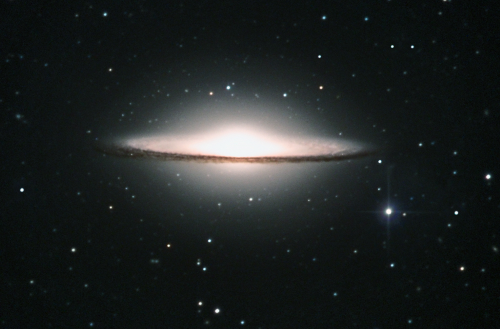Let’s begin our exploration at Zeta (ζ) Corvi, a wide double star within the southern confines of the trapezoid. Shining at 5th magnitude, Zeta shows a subtle hint of blue, while its 6th-magnitude companion, HD 107295, 6′ to the west, is yellowish. Whether they form an actual binary star system or just a chance optical double is open to debate. Zeta is projected to be 415 light-years away, while HD 107295 is calculated at 386 light-years distant. Some ambiguity in the data, however, may mean that they are actually much closer to one another.
Corvus also holds a second widely spaced double star about 2° south of the midway point between Beta (β) and Epsilon (ε) Corvi. The brighter of the pair is 6th-magnitude 6 Corvi, while 5′ to its west is HD 107756, one magnitude fainter. Both are orange giant stars. Slightly defocus your binoculars to enhance their delicate colors.
By extending an imaginary line from Delta (δ) through Beta Corvi along the trapezoid’s western side, and continuing southward for 3½°, you will come to 5th-magnitude HD 109799 in neighboring Hydra. Can you also see a smudge of faint light just to its northeast? That will be M68, a rogue globular cluster lying in the Milky Way’s outer halo, about 33,600 light-years from us. Owing to its southern position in the sky from midnorthern latitudes, M68’s gentle glow can be quickly extinguished by horizon-hugging light pollution and haze. But if you wait for a moonless night, it will reveal itself with just about any binocular. As you strain to see M68, consider that that feeble glow is actually the combined effort of more than 100,000 stars that have been in existence for an estimated 11 billion years.

Want to learn more about pulsars and other extreme objects in our universe? Check out our free downloadable eBook: Exotic objects: Black holes pulsars, and more.
Just north of Gamma Corvi, there is an arrow-shaped asterism of eight 6th- and 7th-magnitude stars that points right at our next target, the Sombrero Galaxy (M104). What could be more convenient than that? The galaxy is just 2° northeast beyond the arrow’s tip, barely across the invisible boundary in Virgo. Although M104 shines at only 9th magnitude, my old 7x35s still reveal its oval disk. Increasing to my 10x50s, that disk grows more prominent, surrounding a stellar core. It takes my 16x70s to reveal why M104 is nicknamed the Sombrero; they reveal a protruding core and broad, flattened disk cleaved by a “brim” of opaque dust.
Finally, look about halfway between the tip of the arrow and M104. Can you see a tiny triangle of faint stars? If you are viewing through 14x or higher giant binoculars, you might notice that there are six stars here, forming a triangle within a triangle. Nicknamed the Stargate, this little object is one of my favorite springtime asterisms.
I always enjoy hearing of your binocular exploits and successes. You can contact me through my website, philharrington.net. Until next time, remember that two eyes are better than one.










